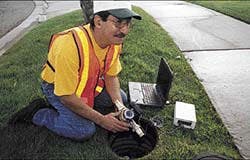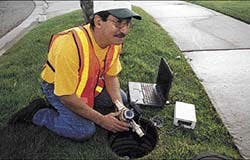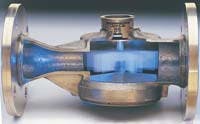Large Meter Replacement Program Sets New Standard
By Arvid "Butch" Hiller, John Kappes and Dennis Bowman
Mountain Water Company (MWC) is a privately held investor-owned water utility that serves a growing population of over 50,000 citizens in Missoula, MT. MWC and its employees strive to provide affordable, high quality water and dependable service to the community, while maintaining the long-term viability of the company through a skilled and dedicated workforce.
As a privately owned utility, MWC's water rates are regulated by the Montana Public Service Commission and reflect the cost to provide water service. Although half of MWC's residential customers are flat rate, MWC believes that metered billing provides the most equitable method of determining the costs of service because it enables customers to be charged according to their water usage. Unless the meters are registering accurately, however, equitable cost distribution among the entire customer base is still not possible.
All of MWC's commercial customers are metered. The utility found that maintaining the accuracy of the compound and displacement type meters used in commercial settings required a rigorous and capital-intensive maintenance and replacement program. The location of many of these meters in pits, basements, and some hazardous locations presented problems every month for the meter readers and periodically for replacement and maintenance. MWC began researching how emerging technology could resolve these problems and improve the efficiency of meter operations overall.
MWC sought a meter that could register a wide range of flows accurately, including low flows, and that would provide long term reliability. It wanted an automated meter reading (AMR) system that was non-proprietary to maintain meter flexibility. The utility was also interested in a drive-by solution for the short term, but wanted the capability to add fixed point if necessary. With both the meter system and AMR setup, MWC needed vendors who could meet its requirements now and provide solutions in the future.
To evaluate various meter and AMR products on the market, MWC used its own internal decision matrix, in-house testing, and references from other utilities across the country. After extensive research and two AMR pilot programs, MWC found Metron-Farnier able to meet both the large meter and AMR needs with Metron's single-jet meter technology and the RAMAR drive-by AMR system. Metron was also able to provide a turnkey installation program whereby their personnel installed all the meters and AMR.
The Metron-Farnier single-jet technology consists of a velocity type meter that incorporates a single tangential jet of water that flows across a paddle wheel or impeller. The impeller is offset from water flowing through the jet such that the water travels perpendicular to the rotational axis of the meter. The meter provides accuracy at a wide range of flows and has tested to register extremely low flows.
A 2-inch single-jet begins registration at 1/16th gallons per minute (gpm), and registers 100 percent accurately from 1/4 gpm to 160 gpm. By comparison, a 2-inch displacement meter is 100 percent accurate only within the operating range of 2 gpm to 160 gpm, per AWWA C700 Characteristics of Displacement Meters. MWC is now getting similar low flow accuracy from 2-inch Metron single-jet meters as it gets from residential 5/8-inch displacement meters. In addition, the Metron meter has just one wetted moving part and carries a five-year warranty, one of the best in the industry.
Since the change-out, the single-jet meters have increased MWC's billing accuracy by 14 percent, or 80,906 billing units (Ccf) per year. Since MWC bills only for water service, the projected payback was not as great as for systems that bill for both water and sewer. However, accounting for only the increased units billed and without considering cost savings, the payback for the project was less than five years.
The RAMAR AMR system has greatly reduced the time needed to read the meters. Using a one-way receiver that collects reads from the meter interface unit, the meter reader simply drives through a reading cycle, and the reads are stored in a laptop computer in the service truck. At the end of the day, the meter reader simply uploads the data into the billing system. This ability to read the commercial meters from the vehicle has reduced the reading time, and has also decreased the meter readers' exposure to certain hazards, including pits, dangerous areas in businesses, and extremely cold weather. The time saved in reading these meters has allowed MWC to redirect day-to-day duties of certain staff to assist in other areas of operations. Additionally, MWC's large meter maintenance program has been virtually eliminated, and the periodic replacement schedules will be greatly extended due to the longer service life of the single-jet meters.
Metron's installation crews completed the installation of 351 meters in just 31 days. Prior to work being conducted, MWC sent out letters to affected customers informing them about the meter change-out program. Metron employees were available all hours of the day and night to avoid affecting customers' businesses by shutting off water. The employees were easily identified by their uniforms, badges, and business cards.
ConclusionMWC is pleased with the results of its large meter change-out program. The entire process was guided by the following corporate directives and operational management practices:- Include the employees who are affected in the problem solving process.
- Identify the actual problems and address them directly, rather than focusing on symptoms.
- Innovate to solve problems by looking at new technology, new ideas, and even new theories.
- Use internal and external experience and knowledge as well as best industry management practices to test possible solutions.
- Select the solution that will best solve current problems, and select vendors who can assist with specific solution implementation as well as unforeseen issues of the present and future.
MWC continues to analyze the results of the large meter change-out program, and so far the solution has solved past problems and met or exceeded expectations. The program has saved MWC critical resources that most businesses find scarce time and money while at the same time improving the utility's ability to serve customers and reduce risk to employees. WW/
About the Authors: Arvid "Butch" Hiller is General Manager / Vice President of Mountain Water Company. John Kappes is Assistant Manager and Dennis Bowman is Senior Meter Reader/Maintenance at the company.


